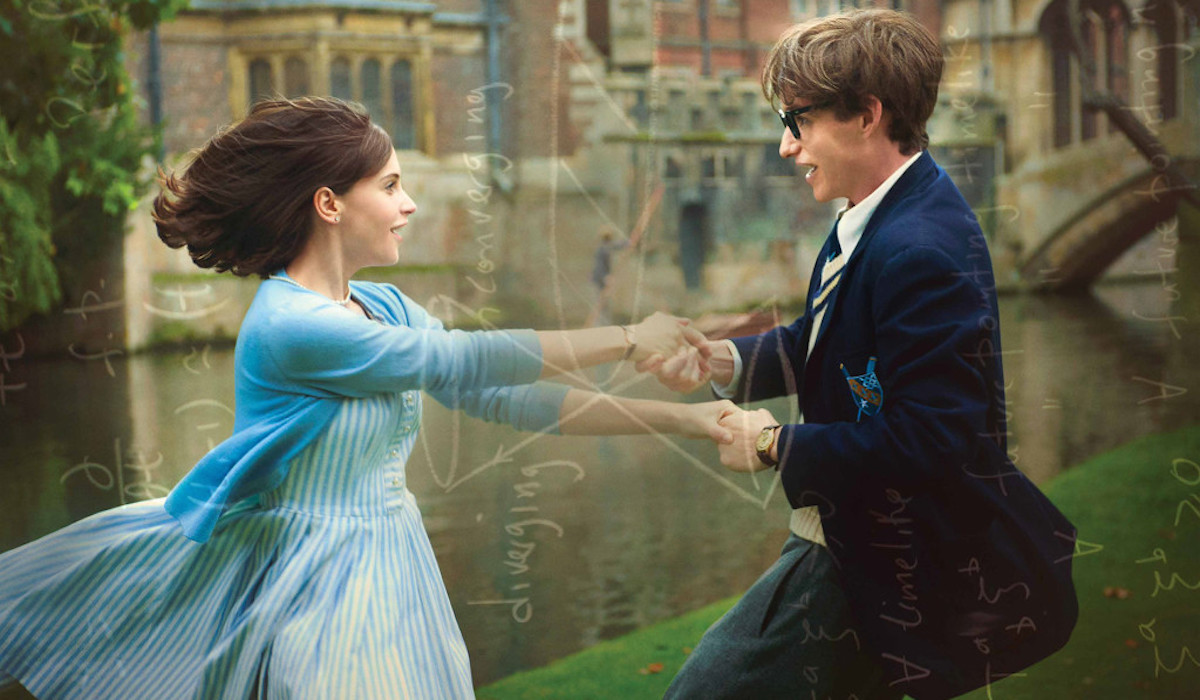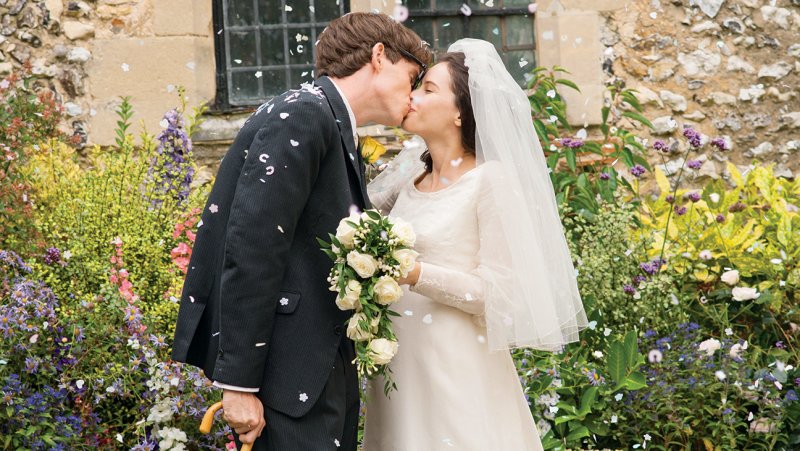La vita-sfida di uno dei cosmologi contemporanei più amati di sempre è ora svelata al grande pubblico attraverso il film biografico e drammatico “La Teoria del tutto” (“The Theory of Everything”), in Italia dal 15 gennaio 2015.
Ma qual è la sfida? Qual è il dramma?
Agli inizi degli anni ’60 del 1900, a Cambridge studiava un ragazzo con gli occhiali storti di nome Stephen Hawking. Amava il croquet e la fisica e lavava le camicie con il Tide.
Una premessa ordinaria per un uomo straordinario, che formulò la teoria della radiazione Hawking, studiò sin dagli anni del dottorato la termodinamica dei buchi neri, scrisse “A Brief History of Time” (1988), l’opera letteraria di divulgazione scientifica che lo collocò definitivamente nell’Olimpo degli scienziati immortali.
E poi venne la malattia, come una doccia fredda, e prima si prese la mano, a soli ventun’anni, e poi lo condannò ad una vita di infermità. La diagnosi era: malattia del motoneurone, quella che oggi si pensa sia un’atrofia muscolare progressiva.
<<Signor Hawking, le prenderà lentamente tutto il corpo, non potrà più muoversi né parlare, nessuno conoscerà più i suoi pensieri, attaccherà i muscoli adibiti alle funzioni vitali>>
<<Quanto mi resta?>>
<<Due anni>>.
E quei due anni divennero cinquanta. Cinquant’anni di studi e di scoperte, sì, ma soprattutto, ed è questo il vero fulcro dell’intero film che sta commuovendo il mondo intero, cinquant’anni d’amore e di speranza.
Questa è la trama, semplice ma densa di emozioni (come forse può esserlo solo la vita), tratta dal libro “Travelling to Infinity: My Life With Stephen” di Jane Wilde, la piccola grande donna che sposò il genio, l’uomo e la malattia.
Il film, di produzione britannica e diretto da James Marsh, sta riscuotendo consensi in tutto il mondo e incrocia le dita per la corsa agli Oscar con le sue 5 nomination come miglior film, miglior attore protagonista, miglior attrice protagonista, miglior sceneggiatura non originale e miglior colonna sonora. Due Golden Globes sono stati già vinti da Johann Johannsson, per la miglior colonna sonora, che insieme a Wagner (grande passione giovanile di Hawking) accompagna e culla la storia, e da Eddie Redmayne come miglior attore protagonista in un film drammatico.
Per quest’ultimo (chi ha visto il film può dirlo) non c’è affatto da stupirsi: una giovane promessa del cinema che incarna, con immensa dolcezza ed eleganza, il senso del limite e dell’immenso: un uomo dilaniato dal dolore e dalla paura del futuro, rinchiuso in un corpo-gabbia, che punta però lo sguardo verso gli unici stendardi della sua vita: la passione per la scienza e la forza titanica della sua Jane.
Lei è invece interpretata da Felicity Jones, un’attrice che si contende magistralmente la scena con il suo co-protagonista. Ha lo sguardo fermo, di una donna che si è trovata al bivio innumerevoli volte e ha scelto sempre la strada giusta (compresa la via della tracheotomia per Hawking, che gli salvò la vita ma lo condannò alla perdita della voce). È riuscita a risaltare il ruolo cardine di una ragazza semplice e fragile che ha preso nelle mani il volto del proprio ragazzo, a poco più di vent’anni, e gli ha detto: affronteremo tutto questo insieme, vada come vada, perché è quel che i nostri cuori vogliono.
Ma l’aspetto più interessante è il dramma del tempo. Chiedersi cosa sia, dove si trovi, se nelle mani di Dio o degli uomini, guardare quello che si ha davanti, voltarsi e cercare di recuperare quello perso, di rivivere quello migliore. Hawking passò buona parte della sua esistenza a rimuginare sul tempo, scientificamente e spiritualmente, a chiedersi cosa lo riempie, cosa lo svuota. Il tempo assume nel corso del film l’aspetto di un soffio e quello di un uragano. Chi guarda, si interroga: ma cos’è che conta? La storia stessa cerca di rispondere passo dopo passo.
Ti regala due giovani ebbri d’amore, insaziabili, inscindibili, al loro primo ballo, al loro primo bacio, e pensi voglia dirti: conta amare, senza fine; poi, ti mette davanti una sedia a rotelle e la dolce promessa e illusione che sia solo una soluzione temporanea, e pensi: conta lottare, sempre; e poi, ti rivela il fardello della malattia e delle responsabilità, e credi: conta sopportare, con coraggio. Ma, verso la fine, ti mostra una conferenza, un’assemblea di estimatori, un riconoscimento regale, un uomo la cui potenza interiore, sorretta dalla tenacia di una donna straordinaria, gli ha regalato una vita in fondo piena di gioie, di soddisfazioni. Svanisce così ogni dubbio su ciò che davvero conta: guardare cosa si è fatto, sperare di far sempre meglio, convincersi che siamo noi gli artefici del nostro futuro, siamo noi gli unici a poterlo plasmare credendoci. Tutti, dal primo all’ultimo, nasciamo pieni di limiti, ma i limiti sono fatti per essere superati, ciò che è importante è esserci, esserci sempre su questa terra in tutti i modi possibili, senza mollare mai, perché, come disse una volta un saggio cosmologo sulla sedia a rotelle:
“Finché c’è vita, c’è speranza”.
Questo è “La Teoria del Tutto”, un romanzo che lascia poco spazio alla scienza e alla sofferenza e pensa alla vita nei suoi tratti più belli, quelli che confermano quanto sia giusto cercare ogni giorno la propria strada nel mondo. Un grazie a Stephen Hawking e a Jane Wilde per l’immensa bellezza che custodiscono nell’anima.
[divider]ENGLISH VERSION[/divider]
The challenging life of one of the most beloved cosmologists ever is now revealed to all people through the biographical and dramatic movie “The Theory of Everything” which has been played in Italian cinemas since January the 15th.
What is the challenge? What is the dramatic situation?
At the beginning of 1960s, there was a boy with twisted glasses named Stephen Hawking who studied in Cambridge. He loved croquet and physics and he washed his shirts with Tide detergent.
A little ordinary information for an extraordinary man, who formulated the “Hawking radiation theory” and had been studied black hole thermodynamics since the years of PhD. He wrote “A Brief History of Time” (1988), the science-book that gave him the immortality in the scientific world.
Then, the disease arrived, as a wet blanket. When he was only 21 the disease hit his hand at first and then condemn him to infirmity. The diagnosis was motor neuron disease, which today is known as amyotrophic lateral sclerosis.
“Mr. Hawking, the disease will affect all parts of your body, you won’t be able to move or to talk with others and anybody won’t know your thoughts anymore, it will attack the muscles used for vital bodily functions.”
“So, how much longer, doctor?”
“Two years”
Those two years became fifty. Undoubtedly, fifty years of studies and discoveries, but above all fifty years of love and hope, and this is what is really touching the whole world.
This is the plot, simple but full of emotions (as only life can be), inspired by the book “Travelling to Infinity, My Life With Stephen” written by Jane Wilde, the little big woman who married the genius, the man, the disease.
The British production movie directed by James March is having success in all parts of the world and it is crossing its fingers for Academic Awards with 5 nominations for Best Movie, Best Actor, Best Actress, Best Adapted Screenplay and Best Soundtrack. Two Golden Globes have been already won. One was given to Johann Johansson for the Best Soundtrack who, together with Wagner (a big passion of Hawking) accompanies the story. The other was given to Eddie Redmayne as Best Actor in a drama. It’s not surprising and those who have already watched the movie can confirm it: a young talent in the world of cinema that personifies, with extraordinary elegance and sweetness, the sense of limit and immensity. He is a man wracked by pain and by the fear for the future, trapped in a caged body, who looks only at the two fundamental values of his life: the passion for science and the incredible strength of his beloved Jane.
Felicity Jones, an actress who skillfully shares the stage with the co-star, interprets the woman. She has a careful gaze, typical of a woman who has been often faced with a choice, always opting for the right one (Hawking’s tracheotomy included, which made him dumb, but saved his life). She succeeded in personifying the key-role of a simple and fragile girl who at the age of 20, has taken into her hands his boyfriend’s face and has told him: Come what may, we’ll face all this together, because this is what our hearts want”.
But the most interesting aspect is the dramatic factor of time. Asking what is it, where is it, wondering if it is governed by God or by men, looking at the time we have to spend and the time we have already spent trying to make up for the lost one and to live again the best one. Hawking spends most of his life wondering about time, both scientifically and spiritually, asking himself what fills it up and what makes it empty. During the movie, time seems to be sometimes a breath of wind and other times a hurricane. People who watch the movie ask themselves -what really matters? The story itself, tries to answer gradually. You watch two insatiable and inseparable people in love, their first dance, their first kiss. You think the story wants to tell you: It’s eternal love that counts; then, you see the wheelchair and the sweet promise and illusion that it will be only a temporary solution and you think: it’s fighting constantly that counts. After that, the movie reveals you the burdens of the disease and responsibility and you think: it is toughing it out that counts. Almost at the end of the film, you watch a conference, a meeting of evaluators, a regal award, a man whose inner strength, supported by the persistence of an extraordinary woman, gave him a joyful and satisfactory life after all. There’s no doubt about what really counts: looking at what we have done, hoping to do always better, convincing ourselves that we decide our own future and that we are the only ones who can shape it if we really want it. Everybody, from the first to the last, has limits, but limits are made to go beyond them. It is life that really counts and living it in the best way possible, without ever giving up. Because, as a famous wise cosmologist said
“While there’s life, there’s hope”.
This is the “Theory of Everything “, a romance that leaves little space to science and suffering and contemplates life in its most beautiful aspects. Those aspects, which confirm how important it is looking for our own way to follow, every single day. Special thanks to Stephen Hawking and Jane Wilde for their immense beauty enshrined in their souls.
Traduzione a cura di Eleonora Boni









